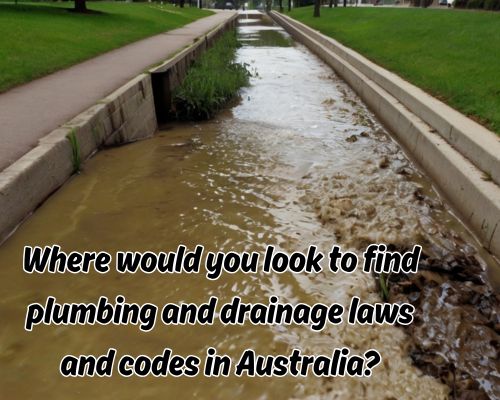
Where Would You Look to Find Plumbing and Drainage Laws and Codes in Australia?
Where Would You Look to Find Plumbing and Drainage Laws and Codes in Australia?
If you’re in Warragul, Victoria, and involved in any sort of building, renovation, or plumbing work—either as a contractor, property developer, or homeowner—it’s essential to understand where to find authoritative plumbing and drainage laws and codes in Australia. These laws aren’t just bureaucratic red tape. They ensure the safety, health, sustainability, and efficiency of water systems in homes and commercial properties. And when it comes to compliance, overlooking even a minor clause could lead to costly fines, work stoppages, or worse—serious safety issues.

With Dean Owens of Plumber Warragul, let’s explore the definitive sources where you’ll find these crucial plumbing and drainage laws, why they matter in local contexts like Warragul, and how Australian regulations harmonise national standards with local enforcement.
🔎 The Primary Source: The Plumbing Code of Australia (PCA)
The Plumbing Code of Australia, or PCA, is the bedrock document that governs all plumbing and drainage work nationwide, including in Warragul. It is Volume Three of the National Construction Code (NCC), a performance-based code that sets minimum requirements for safety, health, amenity, and sustainability across the built environment.
The PCA includes mandates covering:
- Water services
- Sanitary plumbing and drainage
- Stormwater drainage
- Heating and cooling systems
- Backflow prevention
- Material standards and approved methods
💡Where to Access It:
You can access the PCA for free by registering on the Australian Building Codes Board (ABCB) website. The ABCB updates the NCC and its volumes, including the PCA, every three years.
📜 Supporting Standards: AS/NZS Plumbing Standards
Although the PCA outlines what needs to be achieved, it often refers to Australian Standards (AS) and joint Australian/New Zealand Standards (AS/NZS) that detail how those outcomes can be achieved.
Key plumbing standards referenced include:
- AS/NZS 3500 series – Covering water services, sanitary drainage, and stormwater systems
- AS/NZS 6400 – For water efficiency labelling
- AS 4032.1 – Thermostatic mixing valves for temperature control
- AS/NZS 2845 – Backflow prevention devices
💡Where to Access These Standards:
You’ll typically access these through Standards Australia or third-party platforms like SAI Global or Techstreet. These are usually paid resources unless you’re affiliated with a registered training organization or plumbing association.
🏛️ Jurisdictional Legislation: Victorian Plumbing Regulations
National codes are important, but they don’t exist in a vacuum. Each state or territory adopts the PCA through their own legislation. In Victoria, the governing body is the Victorian Building Authority (VBA). For plumbing and drainage work in Warragul, this is your most relevant source.
Victoria’s plumbing work must comply with:
- The Building Act 1993 (VIC)
- The Plumbing Regulations 2018 (VIC)
- The Water Industry Act 1994 (VIC)
- Relevant technical documents and the PCA
💡Where to Access Them:
Head to the VBA’s official website for the latest regulations, compliance certificates, and updates. You can also search legislation on Victorian Legislation website.
🧰 Local Council Requirements: Warragul (Baw Baw Shire Council)
If you’re operating locally in Warragul, your next stop should be the Baw Baw Shire Council, which oversees local planning and development compliance.
Though councils don’t set plumbing laws themselves, they enforce local drainage overlays, environmental controls, and stormwater discharge regulations under the broader plumbing compliance framework. This includes:
- Onsite stormwater detention requirements
- Flood zone restrictions
- Easement encroachments
- Connections to existing council assets
💡Where to Check:
Visit Baw Baw Shire’s official site or contact their planning and building services department directly. They provide guidelines, maps, and permits specific to Warragul and surrounding towns like Drouin, Yarragon, and Longwarry.
🧑🔧 Practitioner Guidance: Licensed Plumbers & Compliance Certificates
An often-overlooked but practical way to find and comply with plumbing codes is by consulting licensed plumbers registered with the VBA. Every licensed plumber must adhere to the PCA, Victorian regulations, and issue compliance certificates for major plumbing work.
For consumers and contractors in Warragul, this creates accountability and a paper trail. It’s also critical for insurance and council inspections.
💡How to Verify:
Use the VBA Practitioner Search to confirm your plumber is licensed and certified to issue compliance documentation.
🔁 Real-World Application in Warragul
Let’s say you’re renovating an older Federation-style home in central Warragul. You’ll likely need to replace ageing copper pipes, improve stormwater runoff, and bring fixtures up to modern energy and water efficiency standards.
Your builder or plumber will need to:
- Reference the PCA for all sanitary and drainage layout standards
- Use materials and installation methods aligned with AS/NZS 3500
- Apply for the relevant permits via Baw Baw Shire Council
- Issue compliance certificates upon completion
- Possibly coordinate with South East Water or another regional water authority
Each step of this local project links back to the national and state-level documentation discussed above—an intricate but necessary web of regulation to ensure everything flows legally and safely.
For plumbing needs, go to Plumber Warragul.
🛠️ Final Thought
Finding plumbing and drainage laws in Australia isn’t about guessing or relying on YouTube tutorials. Whether you’re building from scratch in Warragul’s outer suburbs or updating pipes in a historical cottage, you’ll need to reference the right combination of national codes, Victorian regulations, and local council guidelines.
Smart homeowners and tradespeople don’t wing it—they work with qualified professionals, check authoritative resources, and stay up to date with evolving standards.
Because in plumbing, like life, it’s what’s behind the walls that counts.